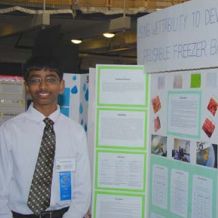 An eighth grade student from Ansonia is one of 300 semi-finalists in a national science and engineering competition.
An eighth grade student from Ansonia is one of 300 semi-finalists in a national science and engineering competition.
Prastik Mohanraj attends the Engineering & Science University Interdistrict Magnet High School in Hamden.
The magnet school is part of the New Haven school system.
Last year Prastik, along with thousands of other sixth, seventh and eighth grade students, entered a project in the “Broadcom MASTERS” science and engineering competition.
“MASTERS” stands for “math, applied science technology and engineering rising stars.”
Prastik set out to formulate a reusuable freezer bag, since so many plastic freezer bags are tossed after one use.
His hypothesis involved using a silicone bag with a cloth inside that could be used several times — while withstanding a deep freeze and warding off bacteria.
He’s already won two awards — and $1,100 — from competitions within the Connecticut Science and Engineering Fair.
On Sept. 17 Prastik will learn whether he’s a finalist in the “Broadcom MASTERS” competition. He would then be eligible for a $25,000 prize.
Prastik is much smarter than the guy writing this article.
Here he is explaining his project in his own words:
Plastic freezer bags always get disposed after one use, creating negative environmental and economic impacts.
A reusable freezer bag for food storage/transport that can alleviate these problems is not readily available on the market.
The purpose of my experiment is to design an environmentally and economically friendly reusable freezer bag with low wettability, satisfactory freezer food preservation, and easy decontamination.
Cloth was used because it is natural and not harmful to food, unlike plastic.
My hypothesis is that from regular cloth, wax-coated cloth, moisture-absorbent cloth, and silicone-cloth bags, silicone-cloth would be the best choice due to its hydrophobicity and resistance to large temperature variations.
The experiment involves the measurement of the bags’ wettability through contact angle, food preservation in freezers, and decontamination of the bags to determine bacteria presence after many uses.
My data showed that the silicone-cloth bag had the least wettability with contact angles approximately 150°, best food preservation, and minimal bacteria growth following decontamination.
I concluded that silicone-cloth was the best material at the given criteria.
New cloth can be reinserted after few uses. But, the same silicone bag can be used for 10 years, decreasing the overall cost and the amount of bags going into the landfills.
Further experiments I would carry out include finding materials that can withstand deep freezing for long periods of time, finding materials that can withstand a freezer as well as a microwave, and finding materials that will not yield any bacteria growth after decontamination following freezer food preservation.